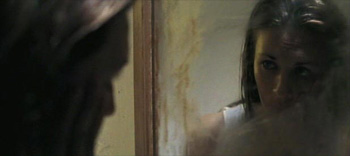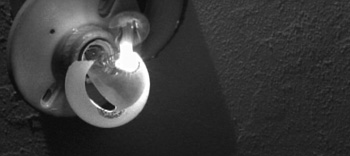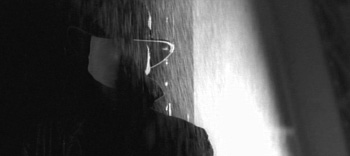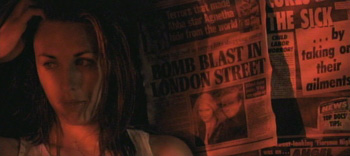
|
FBI SOURCES PERPETUATE HOAX! by Ray Garraty Early dawn in Los Angeles as Mother Spring begins to come alive, the city teems with life. In a two bedroom apartment just outside of Beverly Hills, a set of Ronford tripod legs topped with a Panavision Platinum camera are carefully adjusted within the tile confines of a bathtub. Sandwiched somewhere between the shower head and tile wall is director/cinematographer Jay Holben, framing up the first shot of the morning for Paranoid. Ah, the joys of shooting on location. It is May 9, 1999 and production has just started to roll. Outside, gaffer Mike Collins and his best boy, Manny, are distributing power around the main set where the production will move once the shots in the bathroom are completed. Art director/make-up artist Jennine Dwyer is putting the finishing touches of dirt and grime on actress Tonya Ivey as set decorator Camie Crawford is diligently making the last of the notebook props. Moments later, cameras roll on a wide shot of Tonya in the bathroom and the production is off and running. 
Although this is the first shot of the principal photography day, in three evenings during the prior week, all of the insert work has already been shot. These close-up shots and exterior shots will be carefully interwoven to create the world inside the Woman's mind. "I've gotten some great comments about the insert work in the film, and I'm really proud of those sequences," offers Holben. "Paranoid was shot at the end of a very long week and a half of shooting many different projects. During the course of the week, over several nights, I would take the camera gear home with me and shoot a few of the inserts I needed for the film. These were all done late at night, with no crew, after very long working days - but they were a lot of fun to do." Some of the more memorable sequences include the exploding light bulb and the dying beetle. "I stole the light bulb idea from my youth," admits Holben with a devious gleam in his eye. "Back as a young whipper-snapper I was playing with a BeeBee gun in the house - an automatic no-no - and got a wild hair up my rear to shoot the bare bulb of my bedroom lamp. The BeeBee went clean through the glass (missing the filament) and for a moment - nothing happened. But then a great plume of smoke came out of the hole and the lamp went out. I thought - COOL! For the sequence in Paranoid - I carefully broke the glass portion of a standard light bulb so as to not break the filament inside. Then I took that broken bulb, glued a large portion of the glass back into the socket and paced the bulb in a switched outlet in the ceiling. In the area I was in - the switch to the lamp was behind the door and I had to have the door open to get the camera in the right position - so I tied a string around the light switch and ran it over the door. Then I shot the light bulb - exposing for the "on" position (metered with a regular, intact, bulb) - at 36 fps and once the camera was up to speed I pulled the string and switched on the lamp. Worked like a charm. 
"The Beetle - that was a stroke of luck. I originally wrote in the script for a cockroach to crawl across the floor in a couple of shots. Unfortunately, or luckily - depending on your view-point, there were no cockroaches around for me to recruit. I contacted a service that provides insects and animals for film use and was told that they could easily provide roaches for me - at $100 a roach! Luckily, a friend of mine located a pair of dung beetle in a park and, after meeting with them, I immediately hired them onto the film. These were talented beetles, let me tell you. I told the beetle that I wanted menacing - I wanted gross - I wanted creep-out and BOOM! The darn thing goes and has babies on me - IN THE SHOT! It's a great moment with the beetle on it's back kicking and writhing in what appears to be the throws of death which is actually the pains of baby-beetle birth that worked beautifully to create the perfect creepy shot." One of Holben's fist choices was to take a step away from the common place and cast a woman in the lead role. Although no sex is specified within King's original text, the visual of the woman starkly contrasted with the ravings of what would be expected to be a madman. To embody this role, Holben hired Tonya Ivey, an actress and friend he had met and worked with back in his hometown of Scottsdale, Arizona. "Tonya and I worked pretty closely for about two weeks to really get inside the mind of the woman and hone Tonya's performance. We recorded her voice-over a few days prior to actually shooting with the intention of using her own voice as playback on the set - but I found that it worked much better if we just ran off of single moments and raw emotions for each shot rather than specifically tie a reaction to a particular line of dialogue. It was absolutely crucial to me, however, to maintain 100% integrity to King's words. I very carefully studied the structure of how the text was printed on the page. Where lines were broken - where new paragraphs were made - taking note of each punctuation mark and trying to really understand the cadence that King had created. His words were the backbone to the whole film and I took my cues from the imagery that he created in the poem." The movie was shot on 35mm color film (Kodak Vision 500T 5279) with Panavision cameras and lenses. All of the black and white sequences were also shot on color film but were desaturated in the telecine process by colorist Beau Leon of Santa Monica's Riot Post. "The general idea was that everything inside of the motel room - everything that was real - would be in color. All of her delusions, everything that was inside her mind, would be in black and white," explains the director. "The overall color palette was designed to be muted, dingy and dirty. The walls of the set were covered with a carefully chosen wallpaper to darken her surroundings and seal her tightly in her prison." 
Every one of the newspaper clippings that are taped to the wall is real. Collected from papers like The Globe, The National Enquirer and The Star, each carefully clipping was treated with a light spraying of instant coffee and baked in an oven until they dried. This fairly common technique gives the clippings an authentic aged look. "The notebooks were a bit of a challenge to collect," recalls Holben, "and I often had the feeling that life was imitating art as I went to uncountable office supply stores to collect the right composition books that I was looking for. Not quite 500 drug counters, but it certainly felt like it. "I've been an avid reader of Stephen King's works for a number of years now, and have always been easily swept away by the dynamic imagery of his writing. When I decided to step into the director's chair on a short film in 1999, there really wasn't any question in my mind that 'Paranoid' was the right choice. Back in High School, I had competed in forensic competitions with an interpretation of the poem and had used it as audition material for a number of roles that I took as an actor earlier in my career. It's always been pretty close to my heart. I knew this time around, making a short film, that I would have a limited number of resources and a limited time to complete a project and Paranoid lent itself extraordinarily well to that end. The bulk of production, everything with Tonya that takes place inside the motel room, was shot in a single day. The remaining pieces, all of the black and white portions outside the hotel room were shot over the course of three evenings in the week prior. 
"I wanted to get under people's skin a bit," he explains. "I wanted them to have a chance to look inside the mind of a woman who isn't particularly healthy and not really enjoy being there. . . Paranoid isn't intended to be an audience pleaser as much as a thought provoker - hopefully very much in the vein of King's original prose." in the Director's Notebook! |

home
© 2000 Adakin Productions
Paranoid: A Chant © Stephen King. Used by permission.
All rights reserved.
Digital Film Captures by MAP-MEDIA.com
Last Update 14 Jan 2001
